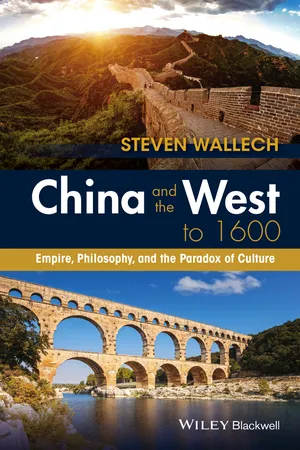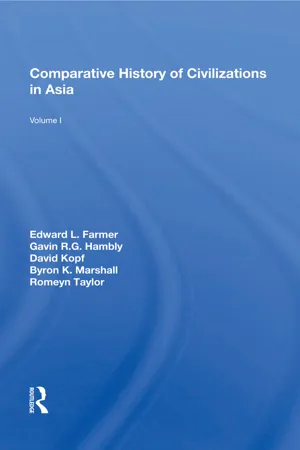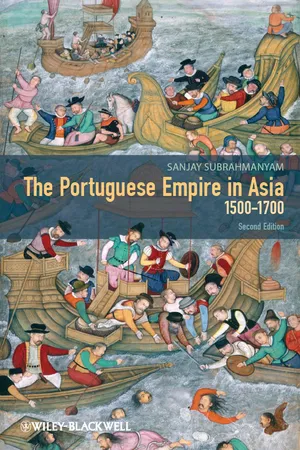History
Medieval East Asia
Medieval East Asia refers to the historical period from roughly the 5th century to the 15th century in the eastern part of the Asian continent, encompassing regions such as China, Korea, and Japan. During this time, East Asia experienced significant cultural, technological, and political developments, including the rise of influential dynasties, the spread of Buddhism, and the flourishing of art and literature.
Written by Perlego with AI-assistance
Related key terms
5 Key excerpts on "Medieval East Asia"
- eBook - ePub
China and the West to 1600
Empire, Philosophy, and the Paradox of Culture
- Steven Wallech(Author)
- 2016(Publication Date)
- Wiley-Blackwell(Publisher)
5 China and Medieval Europe : Cultural Orthodoxy and CreativityThe agricultural and commercial innovations developed by Song China (906–1279), plus the bounty of food production and urban development in medieval Europe during the High Middle Ages (1000–1300), reached full maturity at nearly the same time. The food surpluses generated by both civilizations from 600 to 1300 fed the people that created the geographic internal coherence in each area. Each culture integrated its economic, political, social, philosophical, theological, and religious institutions. China achieved its primary objective, restoration of imperial rule; medieval Europe struggled with a dysfunctional mixture of competing political and religious claims to authority. These diverging cultural developments found full expression in the flowering of each culture’s worldview.While the Early and High Middle Ages (500–1300) was a time of adherence to tradition for both China and Europe, a fundamental difference between the two cultures endured. In the wake of the fall of its ancient civilization, Chinese society operated under a revised but functional political ideology: one that incorporated a political, traditional, and divinely sanctioned belief system that justified the imperial office of each ruling dynasty. This belief system created a revived ideology called “neo-Confucianism” that reinforced the ideals of royal power as had been established during the Han Dynasty. It did so by adding the transcendental influences of Buddhism to the Han’s traditional Confucianism, Daoism, and Legalism. In China’s case, therefore, the “state” and “church” worked in synergy, one solidifying and justifying the other.This flowering of the traditional imagination in China reached full bloom during the Song Dynasty (960–1279). This dynasty produced the greatest amount of wealth that China had seen to date, due to the vibrant commercial economy it fostered (see chapter four - eBook - ePub
- Edward L. Farmer(Author)
- 2019(Publication Date)
- Routledge(Publisher)
The ephemeral political integration of Eurasia under the Mongols was preceded by several developments tending towards a community of civilizations. The spread of the universal religions had created a measure of cultural and religious community that survived regional fragmentation within and among the civilizations. Overland and maritime trade generated mobile, cosmopolitan, commercial classes able to forge economic and, later, political links among the civilizations. Our own era of global politics was prefigured by the early attempts at high-level political cooperation, as between crusading Europe and the imperialist Mongols. The Mongol era was followed by that of the early modern empires, the subject of the following chapter. The Ottoman and Safavid empires in West Asia, the Mughuls in South Asia, Ming China, and Tokugawa Japan all were in some degree products of the disintegration of the Mongol empire and institutionally and culturally influenced by it. One might add Czarist Russia to the list, if this study were not limited to non-European Eurasia.The processes will be discussed in three main categories: first, the formation of a community of civilizations under the aspects of economy, culture, and politics; second, the formation of hybrid barbarian-civilized empires, in which we shall reexamine and enlarge upon processes of military and political interaction that have frequently been noted before; third, the processes associated with the breakup of the Mongol empire.Formation of a Eurasian Community of Civilizations
a. TradeIn the case of trade involving people of several different civilizations, ail obtain goods that would otherwise be scarce or nonexistent in their own regions. They are to this extent enriched in their material culture. It should be borne in mind, however, that this gain was usually enjoyed in this period by relatively restricted classes of people; the high cost of land, and even sea, transport limited goods in trade to those having a high ratio of value to weight and these were of necessity what we might today call luxury goods. Cultural consequences of such trade might include the adoption by a participating civilization of new forms of production as a means of lowering the costs of goods once available only by trade. The adoption of silk cultivation in Syria in the sixth century a d, for example, broke the East Asian monopoly. Moreover, trade in exotic goods did, however vaguely, communicate an awareness to the users of their place of origin, as reflected in the fact that at first Bactrian middlemen, and later the Chinese, were long known in the West as Seres, or "The Silk People." Of even greater importance is the fact that trade generated merchant classes, and these merchants, as dealers in luxury goods, were naturally in association with the wealthy and powerful in the several societies in question. By their wide-ranging contacts and by their skills—including organization, record keeping, economic calculation, knowledge of geography—they were well suited to the service of empire builders, who had a particular interest in being freed of the necessity of having to recruit administrators from the populations they had conquered. - eBook - ePub
Asia in Western and World History: A Guide for Teaching
A Guide for Teaching
- Ainslie T. Embree, Carol Gluck(Authors)
- 2015(Publication Date)
- Routledge(Publisher)
The myriad ways in which religious expansion effected transfers of ideas and institutions among the various lands of Asia are beyond what can be discussed in a brief paper. Suffice it to say that Europe, isolated on the far western extremity of the Eurasian landmass and enjoying comparatively little contact with lands on the south side of the Mediterranean throughout the period in question, both profited and suffered from the relative lack of intellectual and cultural stimulus that the expansion of differing religions and philosophies brought to those parts of Asia that were tied into the great communications systems of the Silk Road and the Indian Ocean. On the positive side, Europe was able to develop its own distinctive medieval Christian civilization without significant challenge or widespread awareness of the arguably richer alternatives available elsewhere. But on the negative side, it suffered from a comparative intellectual stagnation that suddenly became apparent with the translation into Latin of Arabic philosophical and scientific works and the resulting explosion of new ideas and attitudes at the end of our period.CONCLUSION
We have focused in this essay upon four factors facilitating the unusual degree of cultural exchange throughout Asia in the period 300–1200 C.E. Though separated in our analysis, these factors were in many ways interconnected. This was the era of Asian discovery. By this we mean the discovery not of new lands but of the material, technological, religious, and philosophical traditions that had matured in comparative isolation in different parts of Asia during the preceding centuries. And the discoverers were not conquistadors or explorers. They were the thousands of people who walked for months beside their camels across the steppes and mountains of central Asia or sat for weeks beneath a lateen sail on a fragile sailing dhow as it scudded before the monsoon across the Indian Ocean and the South China Sea.Travel was slow and dangerous. Traders and other travelers expected to be away from their homelands and families for many months and even years. They knew that they might well die before they saw their homes again. When we read accounts of arduous journeys by more modern European travelers, we think of them as intrepid individuals pitting their individual stamina and will power, in the best European tradition, against the perilous unknown. But during the era of Asian discovery such perils were commonplace, and the determination of the individual was buttressed by the strength of religious community and the interdependence of people traversing the same route. The goods and ideas they carried overshadow their personal lives, but it should never be assumed that what they did was easy or that cultural contacts across vast distances just happen. - eBook - ePub
Modern East Asia: An Introductory History
An Introductory History
- John Miller(Author)
- 2014(Publication Date)
- Routledge(Publisher)
Like other forms of group identity, ethnicity involves a consciousness of separateness from, and superiority to, outsiders. In premodern East Asia, this “we feeling” was defined in civilizational terms and gave rise to shared traditions and myths. Chinese saw themselves as forming an oasis of civilization in a desert of barbarism, and as the heirs of a timeless and near perfect sociopolitical order. Japanese imagined themselves to be divinely descended and, as such, possessed of peerless virtues and institutions. Koreans prided themselves on their mastery of China’s Confucian civilization, which made them equal to the Chinese and superior to the Japanese. Vietnamese also supposed that they had carried Chinese civilization to a pinnacle of perfection and looked down upon their “barbaric” Buddhist neighbors. Cambodians recalled the lost glories of the Khmer Empire, making the depredations of the Vietnamese and Thai all the more humiliating. Mongols, too, looked back to a golden age under their Great Khans when they had ruled China and much of Eurasia. Both Thai and Burmese regarded themselves as martial peoples destined to rule their weaker and less civilized neighbors.Social and Economic Patterns
The principal socioeconomic divisions in East Asia before modern times were among the nomadic pastoralists of Inner Asia’s steppes and deserts, the rice farmers of Southeast and Northeast Asia, and the hunter-fishers of the northern forests. This tripartite division reflects the climatic factors discussed above. The low temperatures and heavy forest cover of the Russian Far East make it unsuitable for farming and herding or, indeed, any mode of subsistence except foraging. The small bands of Altaic-speaking hunters who roamed this area kept largely to themselves. In contrast, Inner Asian pastoralists interacted closely with China and often menaced it. The grasslands of Manchuria and Mongolia, deserts of Xinjiang, and high plateaus of Tibet are too arid for farming. But they are ideal for herding horses, sheep, camels, and yaks. Mongols and other pastoralists who specialized in this way of life moved seasonally in search of pasture and had few permanent settlements. Although not numerous, they were skilled horsemen and archers. Before the sixteenth-century Gunpowder Revolution, their mobile war bands could often outmaneuver and destroy slower-moving Chinese peasant armies. - eBook - ePub
The Portuguese Empire in Asia, 1500-1700
A Political and Economic History
- Sanjay Subrahmanyam(Author)
- 2012(Publication Date)
- Wiley-Blackwell(Publisher)
bakufu – the “shadow” government of the warlord house of the Tokugawas in Japan, who ruled behind the façade of imperial sovereignty until as late as 1868.And yet, these changes can quite easily be dismissed as of no real consequence, as indeed they have often been by adherents of the “Omar Khayyam approach,” who insist – like the author of the Rubaiyat in its English version – that early modern Asian state-formation is well encapsulated in this verse:Think, in this batter'd Caravanserai Whose Portals are alternate Night and Day, How Sultan after Sultan with his Pomp, Abode his destined Hour, and went his way. (verse XVII)That is to say that these changes represent no more than a replacement of one regime by another, all of which were much the same in essential character. This has, after all, for long been the central thrust of such theories as the “Asiatic Mode of Production,” or “Oriental Despotism,” which stressed the static and unchanging character of both Asian societies and the states that ruled over them. If it is indeed our contention that the states formed in Asia in this period (which we will call early modern) differed from those of an earlier epoch (extending from say the eighth to the fourteenth centuries, which we might term “medieval”), how did they do so?Before we enter into this question, however, it may be useful to differentiate between types of states in early modern Asia. It has been usual to distinguish Asian states of the period under two broad heads: first, the massive, agrarian-based imperial formations, such as the Ottomans, the Safavids, Vijayanagara and the Mughals, the Ming, and Qing in China, and Mataram in Java; in contrast, the relatively small-scale (usually coastal) states like Kilwa, Hurmuz, Calicut, or Melaka, which are thought to have been essentially trade-based, thus drawing their resources not so much from the harnessing of force under prebendal systems as from the control of strategic “choke-points” along key trade routes. Let us consider the Ottomans as an example of the first type. During the fifteenth and sixteenth centuries, their central fiscal institution is seen as the timar, a revenue-assignment given to timariot prebend-holders who rendered military and other services to the state. Despite the attempts to develop central institutions designed to reduce the dependence of the state on such dispersed forces – attempts that are located by historians in particular during the reign of Sultan Süleyman “the Magnificent” (r. 1520–66) – it is argued that the Ottomans could never throw off their character as a state whose fundamental institution was a combination of the classic Islamic iqta’ assignment, and a “feudal” land-grant deriving from the Paleologues, the last dynasty to rule Byzantium. The timar, like its counterpart the jagir
Index pages curate the most relevant extracts from our library of academic textbooks. They’ve been created using an in-house natural language model (NLM), each adding context and meaning to key research topics.




